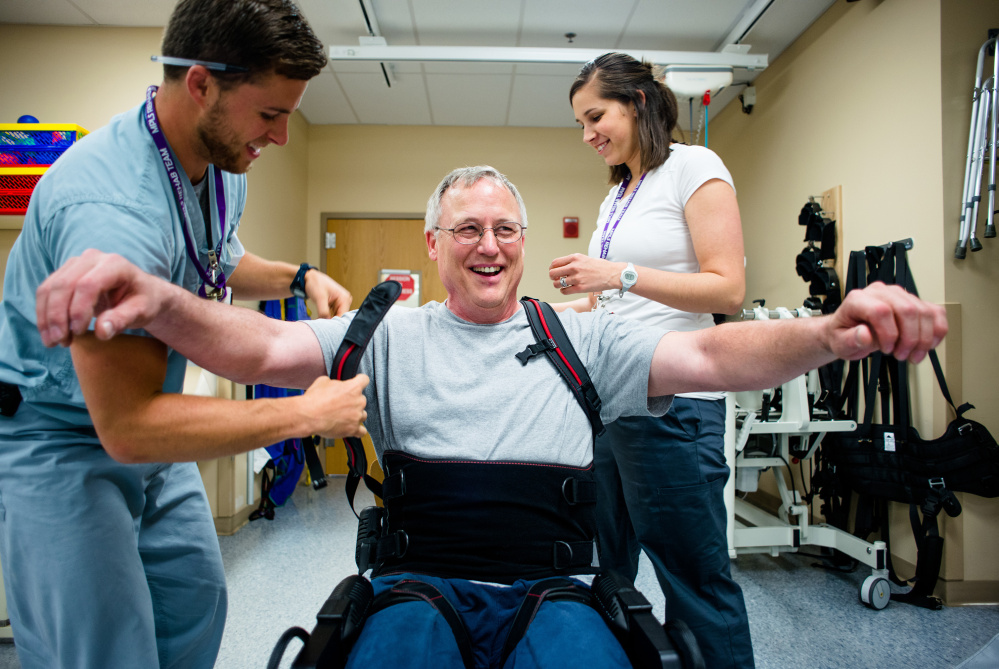MINNEAPOLIS — Robotic technology is helping Doug Eckhoff recover from a spinal cord injury caused by a motorcycle crash that, a decade or so earlier, might have left him unable to walk.
Harnessed in an exoskeleton that supports him but forces him to stride properly, Eckhoff, 56, has been working at the Minneapolis VA Medical Center to regain strength and restore the nerve signals between his brain and legs that make walking possible.
Two months after the Aug. 10 accident, he grunted out five steps with a walker. Now, he walks 200 feet unassisted.
“The first time you stand up and actually take a step like that,” he said, “it’s amazing.”
Eckhoff was one of the first users last year of the Minneapolis VA’s Ekso GT robotic system for spinal cord injuries. Now the hospital has added a second exoskeleton through a donation from the SoldierStrong foundation and the local Fraternal Order of Eagles to help patients recover from stroke and brain injuries.
The robotic exoskeletons are the latest tools in a movement in physical therapy and rehabilitation toward restoring lost function in severely injured patients rather than simply compensating for their losses. Other technologies and approaches, such as a treadmill system that suspends patients over walkways while therapists move their legs, also achieve these goals.
The treadmill approach can have diminishing returns, though, because the therapists tire and stop moving the patients’ legs at optimal gaits, said Elizabeth Koch, a VA physical therapist who works with Eckhoff. “As the therapist gets fatigued, that gets worse.”
Allina Health’s Courage Kenny Rehabilitation Institute added an Ekso device last winter to hasten patients into rehab, said Brian LeLoup, the institute’s director of subacute rehabilitation.
“There is a large and growing body of evidence that the sooner you are up, and the more often you are up, and the more intense and realistic and real-life your activity is, the better your outcomes are,” he said.
Stroke and brain-injured patients often recover some lost mobility through rehab, but LeLoup said research is proving that patients with incomplete injury (partial severing or damage) to the spinal cord can regain some mobility as well.
The Minneapolis VA has used an exoskeleton to help spinal cord injury patients since 2014. Ekso was only federally approved for stroke patients in April, and the VA hospital received a second exoskeleton for that purpose a few days later.
For spinal cord injury patients, the exoskeleton can be programmed to assist them with their steps, and over time can be ratcheted down so patients do the work on their own. When they tire, the robotic system senses the fatigue and kicks in support.
For stroke patients, who might lose function on one side of the body only, the system allows one leg to move unassisted while the other receives support.
Eckhoff remembers flashes of his accident in South Dakota, when an approaching motorcycle lost control and skidded into his bike, and the dread two weeks later when he wondered if he’d ever walk.
Progress was slow, he said, but a milestone came around Christmas when he demonstrated the exoskeleton to his two sons. He was feeling so good that he then set a personal best, walking 150 feet without the device.
Send questions/comments to the editors.



Success. Please wait for the page to reload. If the page does not reload within 5 seconds, please refresh the page.
Enter your email and password to access comments.
Hi, to comment on stories you must . This profile is in addition to your subscription and website login.
Already have a commenting profile? .
Invalid username/password.
Please check your email to confirm and complete your registration.
Only subscribers are eligible to post comments. Please subscribe or login first for digital access. Here’s why.
Use the form below to reset your password. When you've submitted your account email, we will send an email with a reset code.